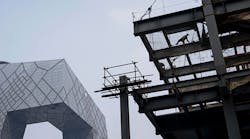BEIJING — China’s manufacturing activity shrank again in October, but the rate of decline slowed, according to an independent survey released Monday.
The sector is key to the health of the economy and is a major driver of global expansion, but has been showing shrinkage for the last eight months. Media group Caixin said domestic demand continued to fall, although new export business improved.
Its Purchasing Managers’ Index (PMI), which tracks activity in factories and workshops, came in at 48.3 last month. The index is closely watched by investors as a barometer of the country’s economic health.
It remained below the break-even point of 50 but marked the smallest contraction since June. It also beat the median estimate of 47.6 in a poll of economists by Bloomberg News.
“The slight upswing shows the manufacturing industry’s overall weakening has slowed down, indicating that previous stimulating measures have begun to take effect,” said He Fan, an economist at Caixin Insight Group.
The Chinese government’s own PMI reading for October, meanwhile, stood at 49.8, unchanged from the previous month, the National Bureau of Statistics said Sunday.
China’s economy expanded 6.9% in the July-September period, the slowest pace since the aftermath of the global financial crisis in 2009, official data showed. Many analysts believe the actual increase was even lower, due to factors such as the weak PMI readings.
The government has taken a series of measures to stimulate growth. On October 23, it cut interest rates by 0.25% — the sixth reduction in a year — and abolished the official cap on interest rates for savers, a liberalizing move.
But government intervention, which struggled to halt a stock market rout this summer has increased doubts over policymakers’ competence in managing a transition to a more market-based economy.
Brian Jackson, an economist with IHS Global Insight, said that with debts mounting, Beijing was likely to further reduce borrowing costs next year. “Significant debt will continue to require refinancing in China in 2016, with further monetary easing likely through the first half,” he said in a note.
The country has seen several corporate bond defaults this year as slowing growth pressures businesses.
The Caixin survey showed domestic demand remained subdued, leading total new business to fall.
Input costs and selling prices both continued dropping as international commodity prices declined, highlighting deflationary pressures.
Copyright Agence France-Presse, 2015



